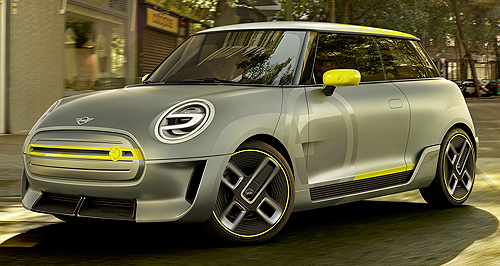Make / Model Search
Future models - Mini - E - Electric conceptFrankfurt show: Mini Electric Concept steps outLook only: Mini is keeping a lid on details of its all-electric powertrain for its 2019 Mini Electric that is set to appear in concept form at Frankfurt. Mini goes sporty in concept for first full-production, full-electric hatchGallery Click to see larger images 30 Aug 2017 MINI has stepped up its two-year launch program for its new-generation all-electric three-door hatch by revealing images of the Mini Electric Concept ahead of its physical debut at the Frankfurt motor show on September 12. Not due to go into production until 2019, the Mini Electric hatch will be a spiritual successor to 2008’s Mini E that was leased in limited numbers as a toe-in-the-water exercise ahead of the rollout of parent company BMW’s i3. Beyond saying the Mini Electric would have a “fine driving range”, no powertrain, performance or driving range data has been provided, although its engineers will undoubtedly dip into BMW’s advanced electric powertrain technology bin that has been honed via various new-generation electrified vehicles including the latest i3 and i8. Unlike the Mini E, the Mini Electric will be a series production car, offered to all markets, including Australia, and sold alongside plug-in hybrid variants, such as the new Countryman PHEV. As GoAuto recently reported, BMW Group Australia corporate communications manager Lenore Fletcher said the new electrified model was “pretty much a no-brainer” for Australian sale, given BMW’s push towards such EVs. The concept revealed overnight appears to be a styling exercise to move the Mini design along, dispensing with some traditional elements such as the chrome exterior trim and black wheel-arch trims while gaining new ones such as large side vents. In that way, Mini customers will have time to get used to impending changes in readiness for a major makeover in the new, fourth-generation model to replace the current car that has done duty since January 2014. BMW chairman Harold Kruger said BMW Group’s strategic plan involved the systematic electrification of the product portfolio. “Mini and electrification make a perfect match,” he said. The Mini Electric is described as an urban car, presumably aimed at major cities where internal combustion engines are increasing frowned on, especially in Europe and ChinaHowever, Mini executives promise the Mini Electric will not lose the brand’s “go-kart feeling” and powerful performance, while also being fun to drive and “completely suitable for everyday use”. On the concept, the grille is mostly closed over for aerodynamic gains, while the front “air intakes” are purely cosmetic. The door handles have been recessed to cut drag. A fibreglass trim down the side of the vehicle adds a sporty touch, extending the wheelarches and adding a couple of side vents in the side skirts. We are betting that a more suitable material will replace brittle fibreglass should this structure go into production. Mini used 3D printing to quickly and easily turn out various cosmetic components for the concept that took just six months to complete. A large E in a circle – the symbol for all Mini electric vehicles in future – is emblazoned on the side of the car in gloss grey on the matte grey body colour. The roof colour flows from matte white to high-gloss yellow, while that yellow is echoed on the exterior mirrors, grille, side skirts and wheel rims. The Mini’s British origins are shown off in the LED tail-lights which have LEDs forming the shape of one half of the Union Jack flag. Pricing will be released much closer to launch time, although the Mini Electric could be expected to slide under the BMW i3 that currently starts as $63,990 plus on-road costs.  Read more18th of August 2017  Mini EV will not rival BMW i3 in AustraliaCountryman PHEV and three-door EV likely local starters for Mini18th of August 2017  Driven: Mini Countryman JCW blasts inSports SUV boom to further drive Mini Countryman JCW growth26th of July 2017  Mini gives green light to EVElectric future opens up for Mini as BMW announces UK-made three-door EVAll future modelsMotor industry news |
Click to shareMini modelsResearch Mini All future modelsMotor industry news |




















 Alfa Romeo
Alfa Romeo Abarth
Abarth Audi
Audi Aston Martin
Aston Martin BMW
BMW Bentley
Bentley Ferrari
Ferrari Chevrolet
Chevrolet Ford
Ford Fiat
Fiat GWM
GWM Foton
Foton Hyundai
Hyundai Honda
Honda Jaguar
Jaguar Isuzu
Isuzu Kia
Kia Jeep
Jeep Land Rover
Land Rover Lamborghini
Lamborghini Maserati
Maserati Lexus
Lexus McLaren
McLaren Mazda
Mazda Mercedes-Benz
Mercedes-Benz Mitsubishi
Mitsubishi Mini
Mini Peugeot
Peugeot Nissan
Nissan Ram
Ram Porsche
Porsche Rolls-Royce
Rolls-Royce Smart
Smart Skoda
Skoda Suzuki
Suzuki Subaru
Subaru Toyota
Toyota Tesla
Tesla Volvo
Volvo Zeekr
Zeekr







Facebook Twitter Instagram